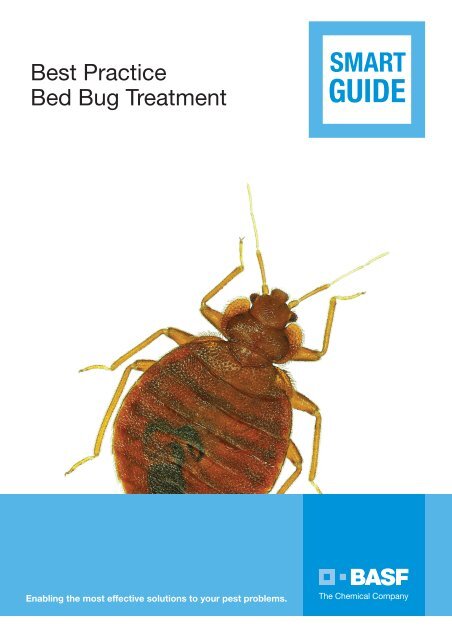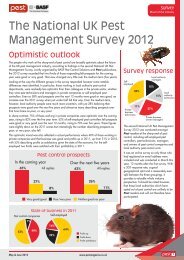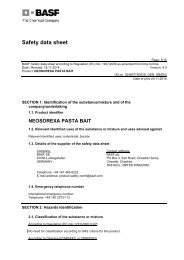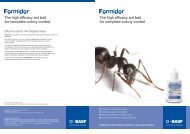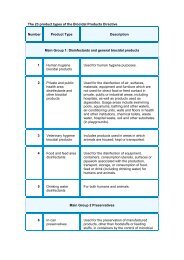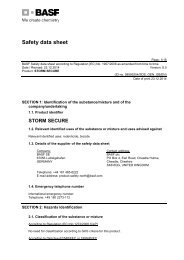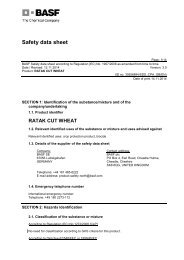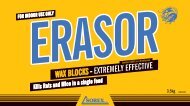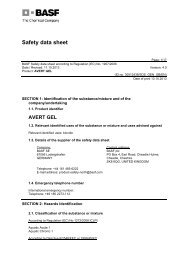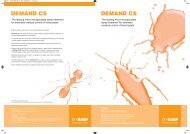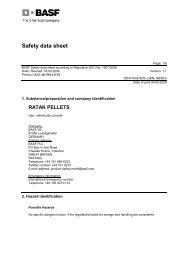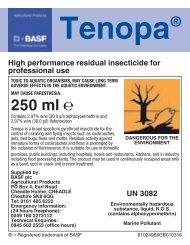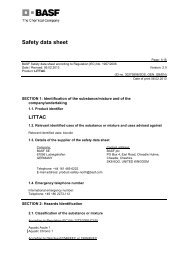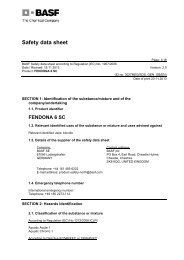Best Practice Bed Bug Treatment - Pest Control Management - BASF
Best Practice Bed Bug Treatment - Pest Control Management - BASF
Best Practice Bed Bug Treatment - Pest Control Management - BASF
Create successful ePaper yourself
Turn your PDF publications into a flip-book with our unique Google optimized e-Paper software.
<strong>Best</strong> <strong>Practice</strong><br />
<strong>Bed</strong> <strong>Bug</strong> <strong>Treatment</strong><br />
SMART<br />
GUIDE<br />
Enabling the most effective solutions to your pest problems.<br />
MP3345 <strong>BASF</strong> <strong>Bed</strong> <strong>Bug</strong> Guide Leaflet.indd 1 29/10/2014 14:35:28
The <strong>Bed</strong> <strong>Bug</strong> Challenge<br />
Few pests pose control challenges as<br />
complex as bed bugs. Hard to find,<br />
persistent, and increasingly pervasive,<br />
bed bugs require considerable<br />
professional expertise and significant<br />
client co-operation to eliminate.<br />
Dense urban populations, major movements of<br />
people and increasing restrictions on residual<br />
insecticides have contributed to a major<br />
resurgence in bed bug problems in recent years.<br />
Although bedrooms continue to be the site of most<br />
infestations, the ability of bed bugs to travel over<br />
great distances on clothing, luggage and furniture,<br />
in particular, means they are found in a wide range<br />
of locations – including offices, schools, shops,<br />
cinemas and public transport.<br />
As well as being alert to such possibilities, this means controllers should<br />
always extend inspections and, if necessary, treatments to other parts of premises<br />
found to be infested.<br />
Recent European research further shows that, even without significant resistance<br />
problems, bed bugs are by far the most difficult insect pest to control.<br />
These multiple challenges make it especially important to tackle bed bugs with a<br />
sound <strong>BASF</strong> Integrated <strong>Pest</strong> <strong>Management</strong> strategy combining proven chemical and<br />
non-chemical methods.<br />
This approach should be based around five key essentials:<br />
1. Inspect to establish the extent and location of the infestation.<br />
2. Prescribe the best treatment strategy for the particular situation.<br />
3. Communicate to set the right expectations and gain sufficient co-operation.<br />
4. Treat using the most effective products in the best and safest ways.<br />
5. Follow-up to assess results and re-treat if necessary.<br />
2<br />
MP3345 <strong>BASF</strong> <strong>Bed</strong> <strong>Bug</strong> Guide Leaflet.indd 2 29/10/2014 14:35:32
Pinpointing the Problem<br />
Wherever bed bug infestations are<br />
suspected a thorough inspection of the<br />
main problem areas is vital to verify their<br />
presence and identify all sites of activity<br />
and harbourage for treatment.<br />
This is crucial because bed bugs are seldom<br />
active during the day and can shelter deep<br />
inside very narrow cracks and crevices.<br />
Being small, the bugs, their eggs and faecal<br />
deposits are easy to overlook without the aid<br />
of a good torch and magnifying tool.<br />
Key areas for inspection include:<br />
• Tufts, seams, buttons & folds of mattresses;<br />
• Box springs, bed frames and covers;<br />
• Couches, chairs, cushions and curtains;<br />
• Window and door mouldings;<br />
• Behind loose wallpaper and pictures;<br />
• Cracks in walls or hardwood flooring;<br />
• Under carpets along walls (tack strip);<br />
• Wall voids (outlets & switch plates); and<br />
• Luggage, boxes and other portable items<br />
Inspectors should be alert for the typical bed<br />
bug odour. They must also be prepared to<br />
move and take apart items of furniture, look<br />
inside electrical fittings and lift carpets along<br />
their edges so that no potential harbourage<br />
sites are ignored.<br />
Wherever evidence of bed bugs is found,<br />
neighbouring rooms and other areas of<br />
the premises should also be inspected to<br />
establish the full extent of the infestation.<br />
Preparing the Ground<br />
With beg bugs, more than any other<br />
insect pest, good preparation of both<br />
the client and the premises ahead of<br />
treatment is central to success.<br />
Clients need to be prepared for the fact<br />
that an initial bed bug treatment may take<br />
five hours or more and involve considerable<br />
disruption, as well as the likelihood that<br />
repeat treatment will be required to achieve<br />
complete control.<br />
They also need to be aware that the<br />
amount of time and number of treatments<br />
needed – and hence the cost – will increase<br />
markedly with the degree of clutter in the<br />
environment; active client and occupant<br />
engagement and co-operation in the process<br />
being essential to its cost-effectiveness.<br />
Laundry<br />
<strong>Bed</strong>s must be completely stripped down<br />
before insecticide treatment, with all sheets,<br />
duvets, blankets, valances and other<br />
bedding placed in a bin liner and either<br />
laundered or professionally cleaned.<br />
Curtains, soft furnishings and any clothing<br />
that may provide potential harbourages<br />
should also be removed for thorough<br />
washing or dry cleaning.<br />
To kill all bed bug stages, materials need to<br />
be washed in hot water (>49ºC for >10 min.)<br />
with soap or detergent before drying in a hot<br />
dryer (>60ºC for >20 min).<br />
Vacuuming<br />
Although their eggs tend to be stuck too tightly<br />
to harbourage surfaces to be easily removed,<br />
vacuuming exposed surfaces or resting sites<br />
is valuable in removing a significant number of<br />
nymphs and adult bed bugs<br />
Using a high efficiency particulate air (HEPA)<br />
filtered vacuum will ensure the many allergens<br />
associated with bed bugs and their debris are<br />
also removed.<br />
Vacuum bags should be removed<br />
immediately, sealed tightly inside a plastic<br />
bag and either incinerated or placed in the<br />
normal rubbish collection.<br />
3<br />
MP3345 <strong>BASF</strong> <strong>Bed</strong> <strong>Bug</strong> Guide Leaflet.indd 3 29/10/2014 14:35:36
Treating the Infestation<br />
Although both heat treatment and freezing will kill bed bugs, for most practical purposes<br />
effective control demands thorough treatment of all infested areas with an insecticide<br />
specifically approved for bed bug control.<br />
10<br />
1<br />
11<br />
3<br />
4<br />
12<br />
2<br />
5<br />
8 9<br />
6<br />
7<br />
4<br />
Initial <strong>Treatment</strong><br />
All harborage areas should be sprayed in strict<br />
accordance with the label.<br />
In particular, in bedrooms:<br />
1. All pictures and other wall hangings should<br />
be removed from wall for thorough crack &<br />
crevice treatment.<br />
2. Drawers should be removed for easy access<br />
to all cracks and crevices on the interior of<br />
the cabinet, as well as the tracks and drawer<br />
supports. Undersides should also be treated.<br />
3. Headboards should be removed from the wall<br />
or dismantled to allow thorough treatment to<br />
cracks, crevices and voids on or behind them.<br />
4. Mattress seams and buttons etc should<br />
be dealt with carefully and generally<br />
vacuuming or non residual insecticide<br />
treatments are recommended.<br />
5. Box springs and bed platforms should<br />
be lifted and turned over for thorough<br />
treatment to all sides, including the<br />
underside and internal areas.<br />
6. Upholstered furniture should be inspected<br />
and treated in a way very similar to bed<br />
and box springs with particular attention<br />
paid to all seams and folds as well as<br />
legs and dust liners on the underside.<br />
MP3345 <strong>BASF</strong> <strong>Bed</strong> <strong>Bug</strong> Guide Leaflet.indd 4 29/10/2014 14:35:36
7. Wheels, casters, posts, and legs of all<br />
furniture should be closely examined<br />
and treated.<br />
8. Carpets should be pulled back from<br />
the wall so that any voids beneath<br />
baseboard mouldings can be treated.<br />
9. Baseboards should be spot-treated,<br />
especially in dark, undisturbed<br />
areas behind the bed or other furniture.<br />
<strong>Treatment</strong> should include any<br />
unsealed seams along baseboard<br />
tops and bottoms.<br />
10. Curtains should be removed from<br />
the window and taken away for<br />
separate treatment (either in a dryer<br />
or steam cleaned).<br />
11. Wall fixtures, such as mounted lamps,<br />
should be detached to vacuum<br />
and treat voids behind them with a<br />
residual dust.<br />
12. Electrical faceplates should be<br />
removed and wall voids behind them<br />
also be vacuumed and treated with<br />
a residual dust.<br />
Residual insecticides should not be applied<br />
to bedding or soft furnishings like cushions,<br />
soft-covered headboards, curtains and<br />
exposed fabric on chairs or sofas.<br />
Wherever possible, these should be<br />
removed in sealed plastic bags for<br />
laundering and high temperature drying.<br />
If this is not possible spot treatments can<br />
be made with non-residual insecticides or,<br />
in some cases, items must be disposed of.<br />
Residual insecticides should also not be<br />
sprayed into air conditioning ducts or<br />
onto warm or hot surfaces.<br />
Additional Considerations<br />
Because bed bugs will move from treated to<br />
untreated areas it is important to ensure that<br />
any neighbouring rooms are also treated.<br />
Although not a statutory requirement, access<br />
to treated areas should be restricted until the<br />
deposit is dry. The time this takes will depend<br />
on conditions, with good ventilation speeding<br />
drying. As a rule, a one hour exclusion period<br />
should generally be sufficient.<br />
Follow-Up<br />
Within approximately 10 days a return visit<br />
should be undertaken and the premises<br />
again inspected thoroughly.<br />
Any areas where bed bugs persist should<br />
be re-treated along with any new areas to<br />
which they may have moved to avoid the<br />
initial treatment.<br />
This follow-up is essential as bed bug<br />
eggs will hatch after the initial treatment.<br />
It is also valuable in identifying any<br />
areas of infestation that may have been<br />
overlooked initially.<br />
Where infestations are heavy a third visit<br />
– after a further 10 days – is recommended.<br />
If possible, hotels should be requested to<br />
leave treated rooms unoccupied until the<br />
infestation is eliminated.<br />
5<br />
MP3345 <strong>BASF</strong> <strong>Bed</strong> <strong>Bug</strong> Guide Leaflet.indd 5 29/10/2014 14:35:38
Making the Most of Fendona ® SC<br />
Fendona ® SC<br />
Fendona ® SC should be the first choice for bed bug treatment. It’s<br />
advanced, low dose, alpha-cypermethrin formulation delivers rapid<br />
knockdown, even coverage and reliable residuality.<br />
As well as being virtually odourless and non-staining, it has very low<br />
toxicity to humans and other warm-blooded animals for the greatest<br />
safety and acceptability in use.<br />
Fendona ® is supplied in 500 ml bottles containing 60g/l of<br />
alpha-cypermethrin as a water-based suspension concentrate for<br />
dilution with water at the rate of 5 ml/litre and application through<br />
all standard knapsack or hand-held sprayers as a coarse, low<br />
pressure spray.<br />
In normal use 25ml of Fendona ® SC in 5 litres of water is sufficient<br />
to treat around 100m 2 of surface, each bottle of product treating<br />
around 2000m 2 .<br />
A double dose is recommended for heavy infestations and for<br />
soiled or highly absorbent and porous surfaces.<br />
<strong>BASF</strong> Example <strong>Treatment</strong> Programme:<br />
Product Active Ingredient <strong>Treatment</strong> Rate Al deposit rate gm/m 2<br />
Fendona ® SC alpha-cypermethrin 60gr 25ml in 5L to treat 100m² 0.015<br />
6<br />
MP3345 <strong>BASF</strong> <strong>Bed</strong> <strong>Bug</strong> Guide Leaflet.indd 6 29/10/2014 14:35:48
Additional resources<br />
For further advice on treatment programmes and to find the best ways<br />
of saving time and money...visit our website and register.<br />
Learn about exciting new pest control products<br />
and developments<br />
Get specialist help with any particular pest<br />
control problem or solution<br />
Download up-to-date datasheets, labels, leaflets, advice<br />
notes and user guides<br />
Check out our real scenario treatment videos<br />
Simply visit www.pestcontrol.basf.co.uk to register your details<br />
and receive our newsletter.<br />
Alternatively you can e-mail us at pestinfo@basf.com<br />
7<br />
MP3345 <strong>BASF</strong> <strong>Bed</strong> <strong>Bug</strong> Guide Leaflet.indd 7 29/10/2014 14:35:51
Key <strong>Bed</strong> <strong>Bug</strong> <strong>Treatment</strong> Guidelines<br />
Thorough inspection and preparation is more important than with any other pest<br />
Good client and occupant engagement and co-operation is essential for success<br />
A significant proportion of bed bug harbourages are beyond the bed itself<br />
<strong>Treatment</strong> may need to extend to locations well beyond bedrooms<br />
Effective control demands high performance insecticides in most situations<br />
<strong>Treatment</strong> generally requires considerable time, good teamwork and several visits<br />
<strong>Treatment</strong> time depends heavily on the extent of clutter and resident co-operation<br />
Specific, non-standard contracts are highly advisable for bed bug treatment<br />
Fendona® contains alpha-cypermethrin.<br />
Fendona ® is a registered trademark of <strong>BASF</strong>.<br />
Use Biocides safely. Always read the label and product information before use.<br />
Further information from:<br />
<strong>BASF</strong> Plc, Professional and Specialty Solutions, Urban and Rural <strong>Pest</strong> <strong>Control</strong><br />
PO Box 4, Earl Road ,Cheadle Hulme, Cheadle, Cheshire, SK8 6QG<br />
Tel: 0161 488 5355<br />
Fax: 0161 485 1137<br />
Email: pestinfo@basf.com<br />
www.pestcontrol.basf.co.uk<br />
MP3345 <strong>BASF</strong> <strong>Bed</strong> <strong>Bug</strong> Guide Leaflet.indd 8 29/10/2014 14:35:52


